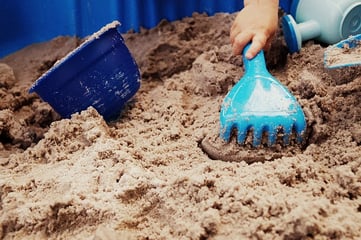Sensory play is one of the best tools for cognitive development in a child’s education. It helps
that when summer comes around there is such an abundance of opportunities for the children to
splash and play.
The Jenny Evolution recognises the importance of sand and water play in child development. Not only does it encourage sensory development, the site says, but it’s also remarkably therapeutic.
 Sand and water play can be effective in many areas. The feeling of water, and the liquid-like flow of sand, can be particularly relaxing for children. And like most things in nature the myriad of ways a child can interact with water and sand is almost infinite.
Sand and water play can be effective in many areas. The feeling of water, and the liquid-like flow of sand, can be particularly relaxing for children. And like most things in nature the myriad of ways a child can interact with water and sand is almost infinite.
The way these substances reacts with the world can be infinitely fascinating for young minds. Channeling water’s flow, blocking its path or watching it pour from one vessel to another seems to be an activity that can entertain them far longer than sticking the Wiggles on Netflix!
A young mind may not know it but dropping things into a pool and watching water spray everywhere is the beginning of an understanding of Newton’s Third Law: "Every action has an equal and opposite reaction".
Even noticing that water speeds up when in a narrow funnel, and slows down when introduced to a wider pool or tunnel is a very early introduction into hydrodynamics. If you want to teach a child about centrifugal force have them fill a bucket with water and spin around with it, holding the handle, arms outstretched. The bucket will be horizontal to the ground yet not a drop will spill.
 Water and sand are some of the best building blocks for understanding the world around us. It’s obvious to most that on a hot day children playing in water is a great way of cooling them down but few realise that the reason it’s so beneficial is that the capillaries in the human wrist sit behind very little fat and muscle so can be cooled a lot quicker, taking the chilled blood back through the body rapidly. Next time you’re overheating run your wrists under a cold tap and feel the benefit.
Water and sand are some of the best building blocks for understanding the world around us. It’s obvious to most that on a hot day children playing in water is a great way of cooling them down but few realise that the reason it’s so beneficial is that the capillaries in the human wrist sit behind very little fat and muscle so can be cooled a lot quicker, taking the chilled blood back through the body rapidly. Next time you’re overheating run your wrists under a cold tap and feel the benefit.
There are hazards to consider with water and sand play that shouldn’t be ignored, some of which are little known yet can be very bad.
For example, you may know that water reflects the sun’s UV rays, at around 10% but you may not know that this is the same amount of reflection that grass gives.
Something else that may surprise you is that sand actually reflects more UV rays than water and
grass, sand can account for up to 25%* reflective radiation. UV levels can be up to 40% higher** in New Zealand than northern hemisphere regions of a similar latitude so ensuring children are protected when playing in or near sand or water is of vital importance.
UV levels can be up to 40% higher** in New Zealand than northern hemisphere regions of a similar latitude so ensuring children are protected when playing in or near sand or water is of vital importance.
Once all precautions have been taken the world of sensory play with water and sand is a limitless gem for a young mind.
A mud and water play table gets children thinking about how gravity affects water, a good height
means children aren’t hunched over and it’s open set-up enables them to collaborate and move
around a lot more than a pool or pit would. It’s also light so can be brought indoors or under the
shade if the conditions change but the fun can’t stop!
The kiset Wharenui can offer a shady retreat for kids needing to cool down or grab 5 minutes out of the sun.
For more summer fun ideas for the centre, visit our website.
*Source: World Health Organisation website
** Source: NIWA.co.nz



